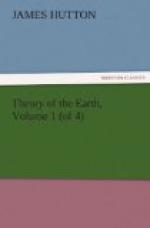It is true, that there are peculiar productions in the mineral kingdom which are rare, as being found only in few places; but these things are merely accidental in relation to the land, for they belong in property to those parts of the mineral region which we never see. Such are, the diamond of the east, the platina of the west, and the tin of Cornwall, Germany, and Sumatra. Gold and silver, though found in many countries, do not appear to be immediately necessary in the production of a habitable country. Iron, again, is universal in the operations of the globe, and is found often in that profusion which equals its utility. Between these two extremes, we find all other minerals, that is to say, here and there in moderate quantity, and apparently in some proportion to their use. But all these substances are to be considered as the vapours of the mineral regions, condensed occasionally in the crevices of the land; and it is only the rocks and strata (in which those mineral veins are found) that are now examined with regard to their original composition, at the bottom of the sea, as well as to that, operation by which those bodies had been indurated in their substance, and elevated from the place in which they had been formed.
Thus, we have sufficient reason to believe, that, in knowing the construction of the land in Europe, we know the constitution of the land in every part of the globe. Therefore, we may proceed to form general conclusions, from the knowledge of the mineral region, thus acquired in studying those parts which are seen.
Having thus found, first, That the consolidated and indurated masses of our strata had suffered the effects of violent heat and fusion; 2dly, That those strata, which had been formed in a regular manner at the bottom of the sea, have been violently bended, broken, and removed from their original place and situation; and, lastly, Having now found the most indubitable proof, that the melting, breaking, and removing power of subterraneous fire, has been actually exerted upon this land which we examine, we cannot hesitate in ascribing these operations as a cause to those effects which are exposed to our view. Now, these may be considered as consisting in the solid state and present situation of those stratified bodies, originally formed by subsidence in the ocean; appearances which cannot, in reason, be ascribed to any other cause, and which, upon this principle, are perfectly explained.




